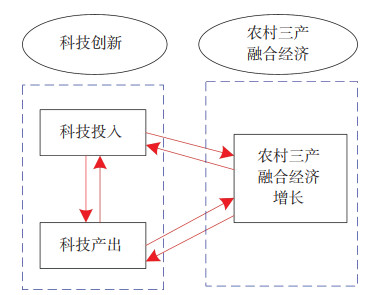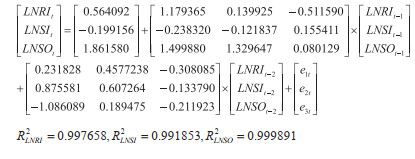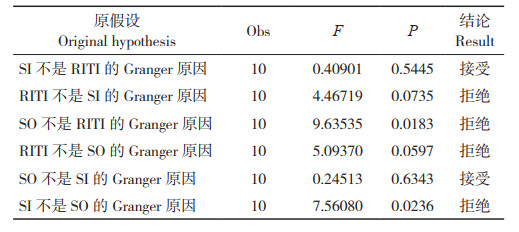文章信息
基金项目
- 国家社会科学基金(21ZDA053-03);山东省人文社会科学课题(2021-ZXCY-16);山东省社会科学规划研究课题(21CPYJ21);潍坊科技学院2022年度社科类校级课题(2022XJSK03);潍坊市社会科学规划重点研究课题(2022-56)
作者简介
- 丁莹莹(1986—),女,博士,教授,研究方向为产业经济理论与政策,E-mail:qingtian629@163.com.
文章历史
- 收稿日期:2022-04-17
【研究意义】科技创新是带动国家技术进步和发展的主要推动力,也是现代化建设进步的主要引导者。近年来,技术发展和科技创新一直是我国重点关注领域,各行业科技创新能力不断提升。与此同时,科技创新还促进我国生产力水平的发展,从而带动经济水平的提高和社会的进步,科技创新成为各国学者一直关注的重点。科技创新投入力度和科技创新产出水平是评价科技创新能力最关键和最基础的指标,我国正处在向创新型国家转变与迈进的重要阶段和关键时期。十九大报告有关“促进农村三产融合发展”和中央一号文件有关“构建农村一二三产业融合发展体系”的决策,都明确指示推动农村三产业融合发展尤为重要,是实现乡村振兴战略、美丽乡村建设、农民富足的有力支撑[1-3]。农村一二三产融合主要影响农产品的生产方式和规模、贸易和销售手段、利益联合机制,衍生和激活农产品进入市场的多种渠道和方式,加快农产品工业转型升级,便于现代农村强化田园综合体模式、休闲农庄发展模式,从而有效地促进农民实现增收。
【前人研究进展】对于科技创新的理解,可以从科技产出与科技投入两个层面展开。本研究试图探索我国科技创新和农村三产融合之间存在的关系,主要针对科技产出(Scientific and technological output,SO)、科技投入(Scientific and technological input,SI)、农村三产融合(Rural integration of three industries,RITI)3个方面的关系进行探讨。其中,科技投入与农村三产融合、科技投入与产出、科技产出与农村三产融合,这3者中两两之间均存在一定的互动耦合关系。国内外学者就上述问题的相关内容进行了较为深入的研究,取得一定的研究成果[4-38]。Kamaruddin等[11]通过实证分析发现投资对农民增收的促进作用比较显著;徐舒婷[32]认为,农村三产一体化,能通过拓展产业链、增加农产品附加值、转移剩余劳动力等方式切实提高农民收入;黄磊等[13]利用Ganger因果检验、VAR模型等方法,获得了研究政府投资、技术创新与经济增长的长期均衡关系;李乾等[14]实地研究发现,通过农村产业的综合发展,土地、劳动力、产品收入、资本等是提高农民收入的具体途径。
【本研究切入点】目前,对农村三产融合的研究成果大多集中在对农民增收具有积极效应的分析探讨中,将农村三产融合与科技创新要素进行有效耦合共轭的相关文献成果相对较少,创新绩效提升和效应持续改进完善的空间仍较大。本研究以此为切入点,研究科技创新与农村三产融合内在关系。【拟解决的关键问题】本研究基于VAR模型,以2011—2019年我国科技及工业相关数据为样本,构建科技产出、科技投入、农村三产融合3个一级指标和9个二级指标体系,对我国农村三产融合与科技创新投入关系进行研究,以期为政府及相关部门提供决策支持和实证启示。
1 数据来源与研究方法 1.1 指标选取参考和借鉴国内外相关文献[1-38],选取和设置指标体系。根据元分析文献检索法,现有研究者在分析评价我国科技创新能力时,多关注科技创新活动的财力、人力投入状况,分别采用R & D全时人员占全社会从业人员的比重、R & D经费内部支出占GDP比重分析研究,并且针对于我国科技产出情况,以科研人员以及专家学者所获得专利数量、发表相关科技论文的数量及参与课题量来表现。在选取经济增长指标上,我国学者普遍倾向于GDP指标。鉴于此,构建一级指标体系包括科技投入、科技产出、农村三产融合。科技投入二级指标分别为R & D全时人员占全社会从业人员的比重、R & D经费内部支出占GDP比重;科技产出二级指标分别为技术市场的成交额、新产品系销售的收入、R & D科研人员平均发表科技论文数量、R & D科研人员平均获得专利数量;农村三产融合二级指标分别为农村三产融合人均GDP、农村三产融合的财政收入、农村三产融合的居民消费水平,形成可测量的评价指标体系(表 1)。

|
1.2.1 熵值法 熵值法最大的优势在于能够客观确定评价指标体系中的评价指标权重,对评价指标权重进行合理赋权,挖掘和提炼评价指标的重要程度和有效程度。目前,在学术界,尚无被公认为科学高效可靠的技术创新评级指标体系的权重赋权方式。因此,本研究采用熵值法对构建的指标体系中的指标权重进行加权。在指标体系中,首选要对n个指标权重进行确定,共包含m年即m个样本,获得初始矩阵如下:

|
第一步对j项指标进行计算,i年份占该指标比重为yij,其中




1.2.2 无量纲化处理 本研究数据来自2012— 2020年《中国科技统计年鉴》《中国工业统计年鉴》,对相关数据进行搜集与整理,通过计算获得9个二级指标以及对应的变量数据。由于各评价指标之间计量单位均不一致,易于对评价指标的数据处理和统计结果的可靠性和科学性产生负面影响,因此,需要进一步对收集整理得到的评价指标数据进行无量纲化处理,可以使用z-score标准化、min-max标准化、归一化等。本研究采用归一化方法进行标准化处理,也就是指标数据整列和为1,在对历年指标数据进行处理时,可设定
1.2.3 计算权重与得分 对指标数据进行无量纲化处理后,再以熵值法进行指标权重赋值,并进行一系列运算,各指标权重和综合得分见表 2、表 3。
1.3 模型构建
1.3.1 概念模型 参考和借鉴相关研究理论成果、相关理论依据和相关理论基础,本研究提出图 1所示的概念模型,阐释科技投入与农村三产融合、科技投入与科技产出、科技产出与农村三产融合三者之间的互动耦合关系和动态逻辑关系。在科技创新体系内部,增加科技投入可以促进科技产出,即为了进一步提高科技产出水平,需要对此投入更多的物力和人力,因而二者关系主要呈现正相关。纵观科学技术发展的理论和实践过程,可以发现农村三产融合和科技创新之间也呈现正相关,增加科技投入,可提高一二三产业产值,促进农村一二三产业一体化,提升社会经济发展水平,引起企业或政府高度重视,提升对科技创新活动投入的强度和力度;反之,科技产出成果进行技术转化,亦可以在农村一二三产业综合发展过程中发挥作用,弥补农村农业发展的空白、建立现代化农业发展体系,确保实现产业兴旺、生态宜居、农民富裕。

|
| 图 1 科技创新与农村三产融合之间关系的概念模型 Fig. 1 Conceptual model of the relationship between scientific and technological innovation and integration of three industries in rural areas |
1.3.2 变量相关性分析 本研究采用SPSS19.0软件对变量进行Pearson相关性检验,检验结果如表 4所示。在科技产出、科技投入、农村三产融合3个一级指标下,9个二级指标变量两两组合,两者间的P值大于0.00、小于0.05,表明二者间的相关性显著,并且其相关系数的绝对值处于0.89~1区域范围内。通过P值可以发现,9个二级指标变量在95% 的置信度下两两间相关性十分显著,其中y3与其他体系指标的相关系数均为负值,表明y3与其他指标呈负相关关系;而其他8个指标之间的相关系数均为正值,即呈正相关趋势。通过研究,y3和其他指标间为负相关的原因,很大可能性在于我国科技论文具有严重的外流现象。与国外期刊相比,我国国内各种科研期刊和学术杂志均存在影响力和品牌力度等较弱的现象,因而越来越多科研工作者和学者将重心转向国外主要学术期刊,我国学术论文发表数量总体排名居世界前列,学术论文发表绝对数量较大,从而导致科研人员发表科研论文数量y3与其他变量间呈现负增长趋势。
2 实证分析 2.1 ADF平稳性检验
为避免产生伪回归,需对系统模型的变量稳定性进行验证,先采用ADF方法对数据进行单位根检验。通过对变量SO、SI、RITI采用自然对数形式,将非平稳时间序列存在的异方差性消除,并且这一消除异方差性的过程与指标的相关关系并没有任何影响。本研究数据全部采用自然对数,假设新生成的变量分别为LNSO、LNSI、LNRI,ADF检验结果见表 5。由表 5可知,LNSO、LNSI、LNRI这3个变量的P值均小于0.05,表明其所存在的相关关系十分显著,单位根的原假设并不存在;ADF平稳性检验结果十分平稳,这表明在95% 的置信度下,可以判定LNSO、LNSI、LNRI全部为平稳时间序列。
2.2 VAR模型构建与分析
VAR模型基于数据统计特性,该模型常用于对多个相互关联的经济指标间的互动关系进行预测和分析,同时考虑了变量之间的动态特征。科技产出、科技投入、农村三产融合间的互动关系需要在较长时间跨度上进行分析,VAR模型能够很好的拟合这种动态关系。本研究将LNSO、LNSI、LNRI 3个变量均判定为平稳时间序列(过程见2.1),因而可以更好地分析经济系统的动态情况。基于此,构建VAR模型,进行指数分析和比较,实证分析过程采用计量软件Eview8。通过SIC、AIC的信息原则,一个是科技投入的滞后期,一个是科技产出的滞后期,将滞后系数设定为2,运行模型得到以下结果:

|
从VAR模型可以发现,这3个方程的拟合性能极佳,拟合度均大于0.98。在LNRI方程中,LNRI的一期、二期滞后值对于指标均具有正相关关系,其相关系数分别为0.232、1.180;LNSI的一期、二期滞后值均全部对LNRI具有正向带动作用,其相关系数分别为0.459、0.141;LNSO的一期与二期滞后均对LNRI有负向影响作用,相关系数分别为-0.513、-0.309,即对于当年的我国农村三产融合综合指标变量而言,可分别用一年前、两年前的科技投入和科技产出6个指数变量来解释。而在LNSI方程中,对于当年的科技投入综合指标变量分析,可以使用一年前、两年前的农村三产融合、科技产出指数等6个指数变量来解释。在LNSO方程中,对于当年科技产出综合指标变量而言,可分别用一年前、两年前的科技投入、农村三产融合的6个变量进行解释。通过表 6中LNSO、LNSI、LNRI 3个残差项的同期相关矩阵相关系数对比分析发现,其中每两个残差项之间的相关矩阵相关系数均大于0.5。
2.3 格兰杰Granger因果检验
Granger于1969年提出Granger因果检验方法,目的在于探讨一个变量是否为另一个变量变动的原因。正常情况下,一个变量对另一个变量的解释程度可以在一定时间内观察到,如果其滞后性增加,则探讨另一个变量的解释程度是否会改变的问题。
一般来讲,科技投入是科技产出的成因,本研究进一步探讨科技产出是否为科技投入的原因,科技产出、科技投入是否为农村三产融合的原因。由Granger因果检验结果(表 7)可知,在10% 置信度下,原假设“SI不是RITI的Granger原因”的F检验P值等于0.543,大于0.1,表明原假设接受;原假设“RITI不是SI的Granger原因”的P值等于0.072,小于0.1,原假设拒绝,也就是在90% 的置信度下,可认为农村三产融合及科技投入间有单边Granger因果关系存在,农村三产融合可以促进提升科技投入。同理,SO是RITI的Granger原因且RITI是SO的Granger原因,农村三产融合和科技产出可相互Granger引发;SO不是SI的Granger原因,SI是SO的Granger原因,科技投入以Granger对科技产出进行引发。以上表明,科技产出、科技投入、农村三产融合3个指标间存在高度相关性,因此,伴随着科技投入促进科技成果产出,同时,将科技成果转化为生产力和生产技术,有利于促进农村三大产业的融合发展并增强农村三大产业的融合能力,反过来又刺激科技投资,3个要素形成了良性互动链(图 2)。

|
| 图 2 格兰杰因果关系示意图 Fig. 2 Granger causal relationship diagram |
3 基于协整检验与ECM模型的关系研究
对于EG检验法来说,基本工作机理在于对一组d阶单整的时序变量,利用普通最小二乘法(Ordinary least square,OLS)估算回归函数,并且把方程的残差项作为随机误差项的估计值,而后对方程的平稳性能进行评价,若评价结果为平稳,则可认定该组变量有(d,d)阶协整关系存在。
3.1 科技投入与科技产出通过对于LNRI、LNSI两个变量进行检测,使用OLS法进行协整方程估算,该样本的回归函数方程为:

|
结果表明,在该方程下,T统计量与F统计量在5% 的置信度下,其所得到的P值均小于0.05,即认为该方程各个系数均不等于零,回归方程成立;可决系数R2数值0.9590,表明模型拟合优度较高,科技产出综合指标中,方程解释的置信度为95%;e4的EG检验结果在临界值1%、5%、10% 状态下分别为-2.848361、-1.989209、-1.601251。协整检验结果表明,我国UI和PGDP二者长期存在相互平衡的关系,但对于短期内二者的变化情况并没有具体研究,因此只能通过构建ECM模型,对UI和PGDP的关系进行分析。在建立ECM模型时,首先是通过观察、分析相关变量,将其长期处于均衡状态的假设提出,而后通过协整检验该组的变量情况。ECM模型为:

|
通过ECM模型,可以从两个角度反映和描述科技产出综合指标(SO)短期动态情况,原因一是偏离长期均衡作用的结果,二是短期科技投入综合指标(SI)作用的结果。在完整的ECM模型中,对科技产出的当期波动而言,科技投入当期的波动起伏程度十分夸张,因而每当科技的投入提高1% 的时候,科技产出也会随着提高1.565%,且对当期科技产出来说,上期误差调整比例为-0.820。
3.2 科技投入与农村三产融合采用OLS法对两个序列变量LNRI、LNSI的协整方程进行模拟估计,从而得到样本回归函数如下:

|
检验结果表明,F统计量和T统计量在0.05显著性水平下的P值全部小于0.05,说明回归方程显著成立,且各系数之间的显著并不为零。方程的计算结果显示,LNRI、LNSI间具有正向相关关系,农村三产融合的综合得分在科技投入综合得分每增加1% 时,会相应增加1.542%。采用EG检验该方程,从而可获得两个变量LNRI、LNSI间是存在着协同关系,e5的EG检验结果在临界值1%、5%、10% 状态下分别为-2.817851、-1.983455、-1.602255,ADF检验T统计量为-1.827636。ECM模型为:

|
模型误差修正系数为-0.386,也就是说农村三产融合和科技投入短期波动对两者长期均衡状态有影响,误差修正项为0.386,对该模型的误差进行适当的优化和调整,从而将其重新回归平衡状态。该模型表明,当科技投入当期出现相关波动时,会导致农村三产融合情况受到严重影响,即每当科技投入提高1% 的时候,农村三产融合也会随着提高1.256%,对于当期农村三产融合而言,前期误差调整力度为-0.386。
3.3 科技产出与农村三产融合采用OLS法对协整方程进行估计,得到样本回归函数:

|
检验结果表明,模型各系数在0.05显著性水平下回归方程成立,且其显著性并不为零,对于整个模型的拟合程度较高,表明两个变量LNRI、LNSO间具有正向相关关系,农村三产融合综合得分在科技产出综合得分每增加1% 时,会增加0.881%,LNRI、LNSO存在长期稳定均衡关系。e6的EG检验结果在临界值1%、5%、10% 状态下分别为-2.817851、-1.983455、-1.602255,ADF检验T统计量为-2.70891。ECM模型为:

|
误差项修正系数为-0.283,也就是农村三产融合和科技产出之间会存在非常短暂的波动情况,同时这一波动也影响着后续均衡状态,但如果通过调节参数对其进行修正,则可以将非平衡状态下的计算模型回归正常。而农村三产融合的当期变动和科技产出的当期投入变动同样具有显著影响,农村三产融合在科技产出当期提高1% 时会提高0.767%,且对于当期农业三产融合而言,前期误差的调整力度为-0.283。
4 结论与建议本研究基于VAR模型,以2010—2018年我国科技发展和工业生产相关数据为样本,对我国农村三产融合与科技创新投入和科技创新产出之间的关系进行分析研究。研究结果显示,通过对9个二级指标变量进行Pearson相关性检验得知,9个二级指标变量之间存在着极高的相关性。VAR模型分析表明,指标体系中科技投入力度、科技产出水平和农村三产融合间存在着动态相互作用和高度相关关系:科技创新投入能促进农村三产融合的发展,农村三产融合在科技产出当期提高1% 时会提高0.767%;农村三产融合的发展会促进科技创新进一步投入,农村三产融合综合得分每增加0.881%,科技产出综合得分增加1%。
基于上述结论,结合国内外学者的相关研究成果[4-38],提出以下对策建议:
(1)农村三产业融合目前在我国仍然处于起步阶段,农业资源环境约束情况下,农村三产融合举措对实现美丽乡村建设、繁荣农村社会发展、农民生活富裕具有重要的意义。产业融合是产业结构演进和产业转型升级过程的一个阶段,从内生动力和外在诱因角度出发,产业融合离不开技术创新驱动、主体利益驱动、市场需求驱动、政府政策驱动等4个方面的驱动,其中技术创新驱动发挥引擎作用。从实证研究结果可知,科技产出当期提高1%,农村一二三产业融合能够提高0.767%,说明农村一二三产业融合程度仍有很大的提升空间和持续改进余地,这与陈璐等[37]研究观点相呼应。因此,推进农村三产融合发展,必须以调整农村的一二三产业结构为前提,以农村经济为基础,采取三次产业互动、制度体系创新等方法,以实现农村制造加工、乡村旅游、农业营销及其他服务业等一体化的完整产业链,实现农村一二三产业的深度融合。
(2)从目前我国农业全要素生产率情况和农业技术创新水平来看,我国农业技术创新能力有待提升,农业技术贡献率盘底,农业科技成果转化和应用较弱。从实证分析结果可以得知,科技创新投入每增加1%,农村三产融合能够提升1.256%。采用创新方式与办法可以突破农村内部壁垒,逐步打通农业和第二、第三产业之间的技术壁垒[38],逐渐将农业和第二、第三产业之间的界限模糊化,为消费者提供多元化的商品和服务需求,实现传统农业与高技术产业之间的深度融合。因此,地方政府和有关部门应大力推进农业科学技术创新,逐步掌握生物育种、先进农机装备、智能农业、生态宜居、生态环境保护等领域核心技术,以攻克技术壁垒。同时,要进一步鼓励各领域科学技术工作者,充分调动广大农业科研人员的工作热情和创新激情,支持农业科学技术工作者开发产品与技术创新,政府积极搭建科技创新联盟平台,出台有利于农业发展的各项政策,增加R & D科技研发投入,为科研工作者提供多层次、全方面的科技创新环境,加快我国农业技术创新步伐,真正落实农村一二三产业深度融合,实现农业社会快速发展,实现农民增收。
| [1] |
段先盛. 中间生产和最终需求对产业结构变迁的影响研究——基于中国投入产出数据的实证检验[J]. 数量经济技术经济研究, 2010, 27(11): 84-99. DOI:10.13653/j.cnki.jqte.2010.11.004 DUAN X S. Research on the influence of intermediate production and final demand on industrial structural changes-An Empirical empirical Test test Based based on China's Inputinput-Output output Data data[J]. The Journal of Quantitative & Technical Economics, 2010, 27(11): 84-99. DOI:10.13653/j.cnki.jqte.2010.11.004 |
| [2] |
高适, 何蒲明. 基于乡村振兴战略的农村三产融合发展研究[J]. 农村经济与科技, 2019, 30(17): 31-33. DOI:10.3969/j.issn.1007-7103.2019.17.011 GAO S, HE P M. Research on the integrated development of rural three industries based on rural revitalization strategy[J]. Rural Economy and Science- Technology, 2019, 30(17): 31-33. DOI:10.3969/j.issn.1007-7103.2019.17.011 |
| [3] |
王丹玉. 农村一、二、三产业融合的路径研究——以湖北省潜江市为例[J]. 企业科技与发展, 2018(7): 31-32. DOI:10.3969/j.issn.1674-0688.2018.07.013 WANG D Y. Research on the path of the integration of primary, secondary and tertiary industries in rural areas-taking Qianjiang City, Hubei Province as an example[J]. Sci-Tech & Development of Enterprise, 2018(7): 31-32. DOI:10.3969/j.issn.1674-0688.2018.07.013 |
| [4] |
孔祥利, 夏金梅. 乡村振兴战略与农村三产融合发展的价值逻辑关联及协同路径选择[J]. 西北大学学报(哲学社会科学版), 2019, 49(2): 10-18. DOI:10.16152/j.cnki.xdxbsk.2019-02-002 KONG X L, XIA J M. The value logical correlation and synergistic path selection of rural revitalization strategy and the integrated development of the three industries in rural areas[J]. Journal of Northwest University (Philosophy and Social Sciences Edition), 2019, 49(2): 10-18. DOI:10.16152/j.cnki.xdxbsk.2019-02-002 |
| [5] |
匡远配, 肖叶. 农村三产融合发展的经济增长效应分析——基于2007-2019年的县域统计年鉴数据[J]. 湖南农业大学学报(社会科学版), 2022, 23(2): 10-17, 91. DOI:10.13331/j.cnki.jhau(ss).2022.02.002 KUANG Y P, XIAO Y. Analysis of the economic growth effect of the integrated development of the three industries in rural areas-based Based on the 2007-2019 county statistical yearbook data[J]. Journal of Hunan Agricultural University (Social Sciences), 2022, 23(02): 10-17+, 91. DOI:10.13331/j.cnki.jhau(ss).2022.02.002 |
| [6] |
葛继红, 王猛, 汤颖梅. 农村三产融合、城乡居民消费与收入差距——效率与公平能否兼得?[J/OL]. 中国农村经济, 2022(03): 50-66. GE J H, WANG M, TANG Y M. The integration of the three industries in rural areas, the consumption and income gap between urban and rural residents: Can efficiency and fairness have both?[J/OL]. Chinese Rural Economy, 2022(03): 50-66. |
| [7] |
陈学云, 程长明. 乡村振兴战略的三产融合路径: 逻辑必然与实证判定[J]. 农业经济问题, 2018(11): 91-100. DOI:10.13246/j.cnki.iae.2018.11.009 CHEN X Y, CHENG C M. The integration path of the three industries in the rural revitalization strategy: logical necessity and empirical judgment[J]. Issues in Agricultural Economy, 2018(11): 91-100. DOI:10.13246/j.cnki.iae.2018.11.009 |
| [8] |
刘建生, 邱俊柯, 方婷. 乡村振兴背景下农村三产融合: 样态类型、发展路径及对策建议——基于中西部多案例分析[J]. 农林经济管理学报, 2022, 21(1): 95-102. DOI:10.16195/j.cnki.cn36-1328/f.2022.01.11 LIU J S, QIU J K, FANG T. The integration of the three industries in rural areas under the background of rural revitalization: types, development paths and countermeasures and suggestions-Based on the analysis of multiple cases in the central and western regions[J]. Journal of Agro-Forestry Economics and Management, 2022, 21(1): 95-102. DOI:10.16195/j.cnki.cn36-1328/f.2022.01.11 |
| [9] |
刘松涛, 王毅鹏, 王林萍. 日本农业六次产业化对破解我国农村三产融合困境的启示[J]. 农业经济, 2018(4): 3-5. DOI:10.3969/j.issn.1001-6139.2018.04.001 LIU S T, WANG Y P, WANG L P. The enlightenment of the sixth industrialization of japan's Japan's agriculture on solving the dilemma of the integration of the three industries in my country's rural areas[J]. Agricultural Economy, 2018(4): 3-5. DOI:10.3969/j.issn.1001-6139.2018.04.001 |
| [10] |
章奇. 第二产业结构调整与科技金融联动发展的关系研究[J]. 科学管理研究, 2016, 34(3): 109-112. ZHANG Q. Research on the relationship between the structural adjustment of the secondary industry and the linkage development of science and technology finance[J]. Scientific Management Research, 2016, 34(3): 109-112. |
| [11] |
KAMARUDDIN R B, AMIR H. The importance of good aquaculture practices in improving fish farmer's income: A case of malaysia[J]. Internation Journal of Social Economics, 2015, 42(12): 1090-1105. DOI:10.1108/IJSE-02-2014-0028 |
| [12] |
江泽林. 农村一二三产业融合发展再探索[J]. 农业经济问题, 2021(6): 8-18. DOI:10.13246/j.cnki.iae.2021.06.003 JIANG Z L. Re-exploration of the integrated development of primary, secondary and tertiary industries in rural areas[J]. Issues in Agricultural Economy, 2021(6): 8-18. DOI:10.13246/j.cnki.iae.2021.06.003 |
| [13] |
黄磊, 程莉. 技术创新、政府投入与经济增长——基于重庆市的实证研究[J]. 经济体制改革, 2016(2): 69-76. HUANG L, CHENG L. Technological innovation, government investment and economic growth: An Empirical empirical study study based based on Chongqing[J]. Reform of Economic System, 2016(2): 69-76. |
| [14] |
李乾, 芦千文, 王玉斌. 农村一二三产业融合发展与农民增收的互动机制研究[J]. 经济体制改革, 2018(4): 96-101. LI Q, LU Q W, WANG Y B. Research on the interactive mechanism of the integrated development of rural primary, secondary and tertiary industries and farmers'income increase[J]. Reform of Economic System, 2018(4): 96-101. |
| [15] |
温小霓, 李俊霞. 科技创新与经济增长之间的关系研究[J]. 西安电子科技大学学报(社会科学版), 2015, 25(6): 58-67. DOI:10.16348/j.cnki.cn61-1336/c.2015.06.006 WEN X N, LI J X. Research on the relationship between technological innovation and economic growth[J]. Journal of Xidian University (Social Science Edition), 2015, 25(6): 58-67. DOI:10.16348/j.cnki.cn61-1336/c.2015.06.006 |
| [16] |
田越歧, 胡金蕾, 汤哲. 科技创新对广西产业结构影响的实证分析——基于VAR模型[J]. 时代金融, 2017(20): 51-52, 54. TIAN Y Q, HU J L, TANG Z. An empirical analysis of the impact of scientific and technological innovation on Guangxi's Industrial industrial Structurestructure-Based on VAR Modelmodel[J]. Times Finance, 2017(20): 51-52, 54. |
| [17] |
张鸿, 刘修征, 郝添磊, 李明甲. 三产融合背景下农村电子商务发展研究——基于层次分析法-熵值法的综合评价模型[J]. 江苏农业科学, 2019, 47(5): 326-331. DOI:10.15889/j.issn.1002-1302.2019.05.075 ZHANG H, LIU X Z, HAO T L, LI M J. Research on the development of rural e-commerce under the background of the integration of the three industries-A comprehensive evaluation model based on the analytic hierarchy process-entropy method[J]. Jiangsu Agricultural Sciences, 2019, 47(5): 326-331. DOI:10.15889/j.issn.1002-1302.2019.05.075 |
| [18] |
由雷. 科技创新对地区经济增长的影响研究——以沈阳市为例[J]. 经济师, 2018(2): 12-15. DOI:10.3969/j.issn.1004-4914.2018.02.005 YOU L. Research on the influence of scientific and technological innovation on regional economic growth-Taking Shenyang City as an example[J]. China Economist, 2018(2): 12-15. DOI:10.3969/j.issn.1004-4914.2018.02.005 |
| [19] |
LEE LEE S H, LEE LEE H K. Measuring and comparing the R & D performance of government research institutes: A bottom-up data envelopment analysis approach[J]. Journal of Informetrics, 2015, 9(4): 942-953. DOI:10.1016/j.joi.2015.10.001 |
| [20] |
LEE T H, ZHANG Y S, JEONG B H. A multi-period output DEA model with consistent time lag effects[J]. Computer & Industrial Engineering, 2016, 93(1): 267-274. |
| [21] |
ZBAY N, KAIRANLAR S. The almon two parameter estimator for the distributed lag models[J]. Journal of Statistical Computation and Simulation, 2017, 87(4): 834-843. DOI:10.1080/00949655.2016.1229317 |
| [22] |
曹祎遐, 黄艺璇, 耿昊裔. 农村一二三产融合对农民增收的门槛效应研究——基于2005-2014年31个省份面板数据的实证分析[J]. 华东师范大学学报(哲学社会科学版), 2019, 51(2): 172-182, 189. DOI:10.16382/j.cnki.1000-5579.2019.02.016 CAO Y X, HUANG Y X, GENG H Y. Research on the threshold effect of the integration of primary, secondary and tertiary industries in rural areas on farmers'income increase: An empirical analysis based on the panel data of 31 provinces from 2005 to 2014[J]. Journal of East China Normal University (Humanities and Social Sciences), 2019, 51(2): 172-182, 189. DOI:10.16382/j.cnki.1000-5579.2019.02.016 |
| [23] |
郑琳琳. 三大技术创新主体科技成果与经济增长关系研究——基于国家创新体系与VAR模型的实证分析[J]. 科技进步与对策, 2016, 33(2): 32-39. ZHENG L L. Research on the relationship between scientific and technological achievements and economic growth of the three major technological innovation entities: an empirical analysis based on the national innovation system and VAR model[J]. Science & Technology Progress and Policy, 2016, 33(2): 32-39. |
| [24] |
JULIE A H. Managing managing uncertainty and expectations: The strategic response of U.S. agricultural cooperatives to agricultural industrialization[J]. Journal of Cooperative Organization and Management, 2015, 3(2): 60-71. |
| [25] |
SARAH R, EVAN D G F. Resilience and the industrial food system: Analyzing the impacts of agricultural industrialization on on food system vulnerability[J]. Journal of Environmental Studies and Sciences, 2015, 5(3): 459-473. |
| [26] |
GEORGE. Land market liberalization, transfer of agricultural technology, and the process of industrialization[J]. Land Use Use Policy, 2013, 35: 388-394. |
| [27] |
RICHARD. Agricultural productivity and industrialization[J]. Forum for Development Studies, 2013, 40(2): 309-325. |
| [28] |
ZHENG W, WANG Z, LIN G P, LIN P. A new business model to Chinese style agricultural industrialization[J]. Emerald Emerging Emerging Markets Markets Case Case Studies, 2012, 2(8): 1-9. |
| [29] |
ZHANG D X, ZHANG X. Transitions of governance mechanisms in China's agriculture: Land reform, the cooperatives, the the People's Commune, HRS and agricultural industrialization[J]. The Kyoto Economic Review, 2007, 76(2): 225-240. |
| [30] |
TURSUN M, TSUYA Y. Analysis of the competition between leading enterprises on the agricultural industrialization industrialization in West West China[J]. Japanese Journal of Farm Management, 2008, 46(1): 183-188. |
| [31] |
MARK D. Agricultural industrialization: Implications for economic development and public policy[J]. Journal of Agricultural and Applied Economics, 1995, 27(1): 13-20. |
| [32] |
徐舒婷. 农村一二三产业融合对农民增收的影响研究——以浙江省为例[D]. 杭州: 浙江财经大学, 2017. XU S T. Research on the influence of the integration of primary, secondary and tertiary industries in rural areas on the increase of farmers'income-Taking Zhejiang Province as an example[D]. Hangzhou: Zhejiang University of Finance and Economics, 2017. |
| [33] |
郑小玉, 刘冬梅, 曹智. 农业科技社会化服务体系: 内涵、构成与发展[J]. 中国软科学, 2020(10): 56-64. ZHENG X Y, LIU D M, CAO Z. Agricultural science and technology socialization service system: connotation, composition and development[J]. Chinese Soft Science, 2020(10): 56-64. |
| [34] |
王丹, 赵新力, 郭翔宇, 胡月, 杜旭. 国家农业科技创新理论框架与创新能力评价——基于二十国集团的实证分析[J]. 中国软科学, 2018(3): 18-35. WANG D, ZHAO X L, GUO X Y, HU Y, DU X. National agricultural science and technology innovation theoretical framework and innovation capability evaluation-based on the empirical analysis of the G20[J]. Chinese Soft Science, 2018(3): 18-35. |
| [35] |
黄红光, 白彩全, 易行. 金融排斥、农业科技投入与农业经济发展[J]. 管理世界, 2018(9): 67-78. DOI:10.19744/j.cnki.11-1235/f.2018.09.007 HUANG H G, BAI C Q, YI X. Financial exclusion, agricultural science and technology investment and agricultural economic development[J]. Journal of Management World, 2018(9): 67-78. DOI:10.19744/j.cnki.11-1235/f.2018.09.007 |
| [36] |
姜玲, 叶选挺, 李磊. 我国农业科技"技术-知识"创新的空间耦合协调格局研究[J]. 管理评论, 2017, 29(9): 122-132. DOI:10.14120/j.cnki.cn11-5057/f.2017.09.011 JIANG L, YE X T, LI L. Research on the spatial coupling coordination pattern of"technology-knowledge"innovation in agricultural science and technology in my country[J]. Management Reviews, 2017, 29(9): 122-132. DOI:10.14120/j.cnki.cn11-5057/f.2017.09.011 |
| [37] |
陈璐, 李玉琴, 王颜齐. 新型农业经营主体推动农村三产融合发展的增收效应分析[J]. 学习与探索, 2019(3): 116-123. CHEN L, LI Y Q, WANG Y Q. Analysis of the income-increasing effect of new agricultural business entities promoting the integrated development of the three industries in rural areas[J]. Study & Exploration, 2019(3): 116-123. |
| [38] |
吴光炜. 关于加快农村三产融合发展的对策研究[J]. 菏泽学院学报, 2017, 39(6): 78-81. DOI:10.16393/j.cnki.37-1436/z.2017.06.017 WU G W. Research on the countermeasures of accelerating the integration of the three industries in rural areas[J]. Journal of Heze University, 2017, 39(6): 78-81. DOI:10.16393/j.cnki.37-1436/z.2017.06.017 |
| [39] |
佟宇竞. 基于国内先进城市比较视角的都市农业经济发展战略思路与路径——以广州为例[J]. 广东农业科学, 2022, 49(1): 167-176. DOI:10.16768/j.issn.1004-874X.2022.01.020 TONG Y J. Strategic thinking and path of urban agricultural economic development based on the comparative perspective of domestic advanced cities-Taking Guangzhou as an example[J]. Guangdong Agricultural Sciences, 2022, 49(1): 167-176. DOI:10.16768/j.issn.1004-874X.2022.01.020 |
| [40] |
梅双, 邵卓. 农业科技推广模式创新与探索实践——以广东省农业科学院惠州现代农业促进中心为例[J]. 广东农业科学, 2021, 48(4): 151-160. DOI:10.16768/j.issn.1004-874X.2021.04.020 MEI S, SHAO Z. Innovation and exploration practice of agricultural science and technology extension model-Taking Huizhou Modern Agriculture Promotion Center of Guangdong Academy of Agricultural Sciences as an example[J]. Guangdong Agricultural Sciences, 2021, 48(4): 151-160. DOI:10.16768/j.issn.1004-874X.2021.04.020 |
(责任编辑 邹移光)
 2022, Vol. 49
2022, Vol. 49









